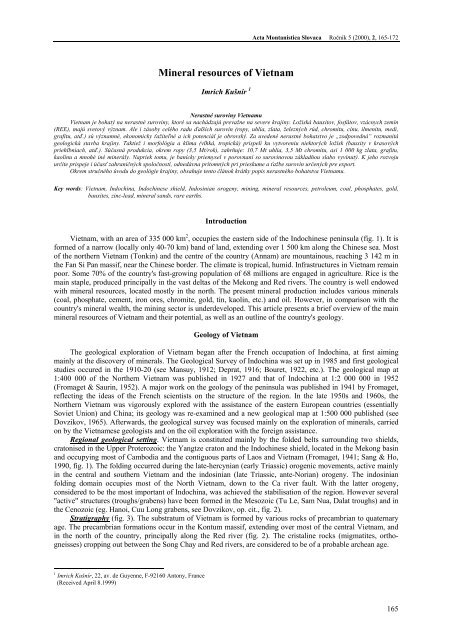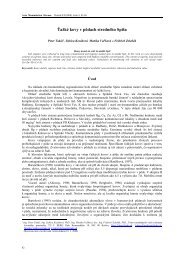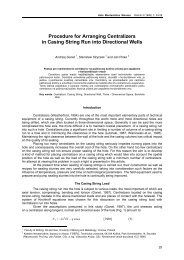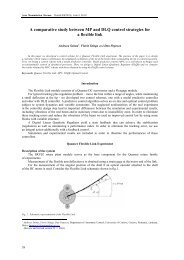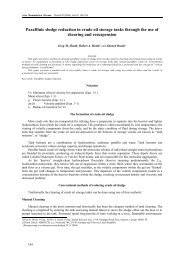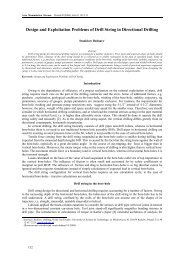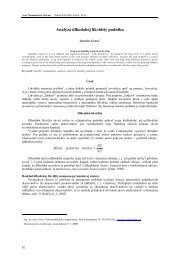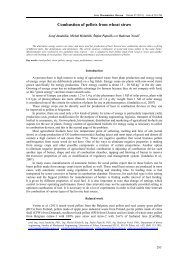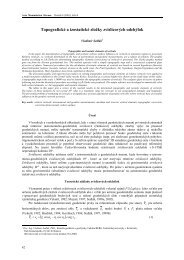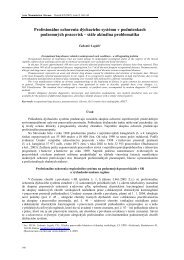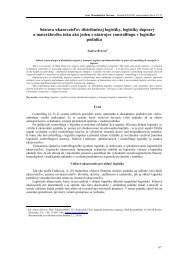Kušnír: Mineral resources of Vietnam - Acta Montanistica Slovaca
Kušnír: Mineral resources of Vietnam - Acta Montanistica Slovaca
Kušnír: Mineral resources of Vietnam - Acta Montanistica Slovaca
You also want an ePaper? Increase the reach of your titles
YUMPU automatically turns print PDFs into web optimized ePapers that Google loves.
<strong>Mineral</strong> <strong>resources</strong> <strong>of</strong> <strong>Vietnam</strong><br />
Imrich <strong>Kušnír</strong> 1<br />
<strong>Acta</strong> <strong>Montanistica</strong> <strong>Slovaca</strong> Ročník 5 (2000), 2, 165-172<br />
Nerastné suroviny <strong>Vietnam</strong>u<br />
<strong>Vietnam</strong> je bohatý na nerastné suroviny, ktoré sa nachádzajú prevažne na severe krajiny. Ložiská bauxitov, fosfátov, vzácnych zemín<br />
(REE), majú svetový význam. Ale i zásoby celého radu ďalších surovín (ropy, uhlia, zlata, železných rúd, chromitu, cínu, ilmenitu, medi,<br />
grafitu, atď.) sú významné, ekonomicky ťažiteľné a ich potenciál je obrovský. Za uvedené nerastné bohatstvo je „zodpovedná“ rozmanitá<br />
geologická stavba krajiny. Taktiež i morfológia a klíma (vlhká, tropická) prispeli ku vytvoreniu niektorých ložísk (bauxity v krasových<br />
priehlbniach, atď.). Súčasná produkcia, okrem ropy (3,5 Mt/rok), zahrňuje: 10,7 Mt uhlia, 3,5 Mt chromitu, asi 1 000 kg zlata, grafitu,<br />
kaolínu a mnohé iné minerály. Napriek tomu, je banícky priemysel v porovnaní so surovinovou základňou slabo vyvinutý. K jeho rozvoju<br />
určite prispeje i účasť zahraničných spoločností, odnedávna prítomných pri prieskume a ťažbe surovín určených pre export.<br />
Okrem stručného úvodu do geológie krajiny, obsahuje tento článok krátky popis nerastného bohatstva <strong>Vietnam</strong>u.<br />
Key words: <strong>Vietnam</strong>, Indochina, Indochinese shield, Indosinian orogeny, mining, mineral <strong>resources</strong>, petroleum, coal, phosphates, gold,<br />
bauxites, zinc-lead, mineral sands, rare earths.<br />
Introduction<br />
<strong>Vietnam</strong>, with an area <strong>of</strong> 335 000 km 2 , occupies the eastern side <strong>of</strong> the Indochinese peninsula (fig. 1). It is<br />
formed <strong>of</strong> a narrow (locally only 40-70 km) band <strong>of</strong> land, extending over 1 500 km along the Chinese sea. Most<br />
<strong>of</strong> the northern <strong>Vietnam</strong> (Tonkin) and the centre <strong>of</strong> the country (Annam) are mountainous, reaching 3 142 m in<br />
the Fan Si Pan massif, near the Chinese border. The climate is tropical, humid. Infrastructures in <strong>Vietnam</strong> remain<br />
poor. Some 70% <strong>of</strong> the country's fast-growing population <strong>of</strong> 68 millions are engaged in agriculture. Rice is the<br />
main staple, produced principally in the vast deltas <strong>of</strong> the Mekong and Red rivers. The country is well endowed<br />
with mineral <strong>resources</strong>, located mostly in the north. The present mineral production includes various minerals<br />
(coal, phosphate, cement, iron ores, chromite, gold, tin, kaolin, etc.) and oil. However, in comparison with the<br />
country's mineral wealth, the mining sector is underdeveloped. This article presents a brief overview <strong>of</strong> the main<br />
mineral <strong>resources</strong> <strong>of</strong> <strong>Vietnam</strong> and their potential, as well as an outline <strong>of</strong> the country's geology.<br />
Geology <strong>of</strong> <strong>Vietnam</strong><br />
The geological exploration <strong>of</strong> <strong>Vietnam</strong> began after the French occupation <strong>of</strong> Indochina, at first aiming<br />
mainly at the discovery <strong>of</strong> minerals. The Geological Survey <strong>of</strong> Indochina was set up in 1985 and first geological<br />
studies occured in the 1910-20 (see Mansuy, 1912; Deprat, 1916; Bouret, 1922, etc.). The geological map at<br />
1:400 000 <strong>of</strong> the Northern <strong>Vietnam</strong> was published in 1927 and that <strong>of</strong> Indochina at 1:2 000 000 in 1952<br />
(Fromaget & Saurin, 1952). A major work on the geology <strong>of</strong> the peninsula was published in 1941 by Fromaget,<br />
reflecting the ideas <strong>of</strong> the French scientists on the structure <strong>of</strong> the region. In the late 1950s and 1960s, the<br />
Northern <strong>Vietnam</strong> was vigorously explored with the assistance <strong>of</strong> the eastern European countries (essentially<br />
Soviet Union) and China; its geology was re-examined and a new geological map at 1:500 000 published (see<br />
Dovzikov, 1965). Afterwards, the geological survey was focused mainly on the exploration <strong>of</strong> minerals, carried<br />
on by the <strong>Vietnam</strong>ese geologists and on the oil exploration with the foreign assistance.<br />
Regional geological setting. <strong>Vietnam</strong> is constituted mainly by the folded belts surrounding two shields,<br />
cratonised in the Upper Proterozoic: the Yangtze craton and the Indochinese shield, located in the Mekong basin<br />
and occupying most <strong>of</strong> Cambodia and the contiguous parts <strong>of</strong> Laos and <strong>Vietnam</strong> (Fromaget, 1941; Sang & Ho,<br />
1990, fig. 1). The folding occurred during the late-hercynian (early Triassic) orogenic movements, active mainly<br />
in the central and southern <strong>Vietnam</strong> and the indosinian (late Triassic, ante-Norian) orogeny. The indosinian<br />
folding domain occupies most <strong>of</strong> the North <strong>Vietnam</strong>, down to the Ca river fault. With the latter orogeny,<br />
considered to be the most important <strong>of</strong> Indochina, was achieved the stabilisation <strong>of</strong> the region. However several<br />
"active" structures (troughs/grabens) have been formed in the Mesozoic (Tu Le, Sam Nua, Dalat troughs) and in<br />
the Cenozoic (eg. Hanoi, Cuu Long grabens, see Dovzikov, op. cit., fig. 2).<br />
Stratigraphy (fig. 3). The substratum <strong>of</strong> <strong>Vietnam</strong> is formed by various rocks <strong>of</strong> precambrian to quaternary<br />
age. The precambrian formations occur in the Kontum massif, extending over most <strong>of</strong> the central <strong>Vietnam</strong>, and<br />
in the north <strong>of</strong> the country, principally along the Red river (fig. 2). The cristaline rocks (migmatites, orthogneisses)<br />
cropping out between the Song Chay and Red rivers, are considered to be <strong>of</strong> a probable archean age.<br />
1 Imrich <strong>Kušnír</strong>, 22, av. de Guyenne, F-92160 Antony, France<br />
(Received April 8.1999)<br />
165
<strong>Kušnír</strong>: <strong>Mineral</strong> <strong>resources</strong> <strong>of</strong> <strong>Vietnam</strong><br />
Fig.1. Tectonic map <strong>of</strong> <strong>Vietnam</strong>. 1-Cenozoic troughs, 2-Mesozoic<br />
throughs, 3-Area <strong>of</strong> Indosinian folding (Lower Triassic), 4-Area <strong>of</strong><br />
Late-hercynian folding (Lower Triassic), 5Kontum massif, 6-Trap`<br />
basalts, 7-Granite massifs, 8-Proterosoic, 9-Faults.<br />
Fig.2. Simpli field geological map <strong>of</strong> <strong>Vietnam</strong>. 1°-Quaternary,<br />
2-Basalts (traps), 3-Jurassic – Cretaceous, 4-Trisassic, 5-Paleozoic,<br />
6-Proterozoic, 7-Granites, 7-Major faults.<br />
Paleozoic formations are quite spread in <strong>Vietnam</strong>. They comprise cambrian series, thick silurian formations<br />
(schists, sandstones ...) and devonian and permo-carboniferous limestones, covering vast areas in Annam and the<br />
northern <strong>Vietnam</strong>, extending to China. Lower and middle triassic series are mainly terrigenous (schists,<br />
sandstones) and volcanic. After the indosinian orogeny, during the Norian, continental series, containing large<br />
coal deposits in the northern <strong>Vietnam</strong>, were laid down. In the troughs formed in Jurassic and Cretaceous, thick<br />
continental series and volcanics were piled up. Tertiary and quaternary formations are deposited in several<br />
grabens & troughts, the most important <strong>of</strong> which are located in the Mekong and Red rivers deltas. Pliopleistocene<br />
tholeitic basalts (traps) form vast plateaus in southern <strong>Vietnam</strong> (fig. 2).<br />
Magmatism, intrusive rocks. Proterozoic intrusives comprise granites <strong>of</strong> the Chu Lai and the Tumorong<br />
massifs, in the southern <strong>Vietnam</strong>, dated <strong>of</strong> 2 300 Ma (Nguyen, 1988) as well as the basic rocks <strong>of</strong> the Bao Ha -<br />
Ca Vinh complexes and the granitic rocks, <strong>of</strong>ten gneissic, <strong>of</strong> the Song Chay massif in the north. Several<br />
phanerozoic intrusive/magmatic series, have been distinguished:<br />
Upper paleozoic, including granites (ex. Loa Son, Dien Binh massifs, in the south, dated 250-360 Ma,<br />
see Nhan, 1988, and Nam Rom, Moung Lat massifs in the NE, yielding K/Ar ages between 252 and 268 Ma<br />
- Dovzikov, 1965), basic rocks (Vitthulu complexe) and permian effusions;<br />
Triassic, emplaced during the indosinian orogeny, most widely spread in <strong>Vietnam</strong>, comprising a large<br />
variety <strong>of</strong> rocks, from ultramafic (ex. Bang Xang, Nui Nua massifs) to granitic intrusives (ex. Vanh Canh in<br />
Kontum and Pia Bioc in the north <strong>of</strong> a K/Ar age between 215 and 240 Ma);<br />
166
<strong>Acta</strong> <strong>Montanistica</strong> <strong>Slovaca</strong> Ročník 5 (2000), 2, 165-172<br />
Upper Cretaceous-Paleogene, comprising alcaline, effusive rocks, granites (Pia Oac, Dinh Quan<br />
massifs, 98 and 86 Ma, Fan Si Pan, 33-56 Ma), syenites (Nam Se, 40-56 Ma) as well as some gabbros and<br />
peridotites.<br />
⇐<br />
Fig.3. Stratigraphy <strong>of</strong> the vietnamese sedimentary and magmatic formations<br />
Adapted after Dovzikov).<br />
<strong>Mineral</strong> <strong>resources</strong><br />
History <strong>of</strong> exploration and mining, present<br />
mineral production<br />
Copper, zinc, tin and gold have been mined in <strong>Vietnam</strong><br />
since the Bronze age and silver, iron and some non-metallics<br />
(especially kaolin) probably since the 1st century B.C. They were<br />
extracted mostly by chinese miners, migrating to <strong>Vietnam</strong><br />
especially under the Ming dynasty; "Chinese workings" are found<br />
on numerous mineral deposits. The exploitation <strong>of</strong> the country<br />
mineral <strong>resources</strong> was intensified after the French occupation <strong>of</strong><br />
Indochina in 1884. Coal, gold, tin, chromite, zinc, antimony,<br />
apatite, talc and some other minerals were exploited from the<br />
beginning <strong>of</strong> this century, mainly for the export to France<br />
(Blondel, 1931). Some industrial minerals were produced for a<br />
local use: cement and constuction materials, dimension stones.<br />
During the 2nd world war, practically all mineral export was<br />
directed to Japan. After the achievement <strong>of</strong> the independance (in<br />
1956), in the Northern <strong>Vietnam</strong>, a vigorous exploration and the<br />
restoration <strong>of</strong> mining industry was carried out with the assistance<br />
<strong>of</strong> the eastern European countries and China. Were restored, between others: Hon Gay coal mines, Lao Cai<br />
phosphate mines and cement plant in Hai Phong. Then the Thai Nguyen steel plant was built and production <strong>of</strong><br />
the iron ores started. After the re-unification <strong>of</strong> the country in 1976, the exploration has been carried on by<br />
<strong>Vietnam</strong>ese geologists. Several important deposits were discovered in the south (bauxites, mineral sands, see<br />
Xing, 1988). Oil exporation with soviet assistance, lead to a discovery <strong>of</strong> petroleum in 1987; an oil refinery,<br />
located near Ho Chi Minh City, came on line in 1988. At present, <strong>Vietnam</strong> produces approximately 3,5 Mt <strong>of</strong><br />
crude oil/year and its mineral production includes: coal (about 10,7 Mt/y), cement (1,6 Mt), phosphate (300 000<br />
t), chromite (3,5 Mt), iron ores, gold (around 1 000 kg, including production by the local population), cassiterite<br />
(3 000 ? t), graphite, kaolin and many other minerals produced for the local market/use. Several foreign<br />
companies are involved in the oil exploration (BP, Total, BHP) as well as in prospecting (seldom in exploitation)<br />
for minerals (mainly Australian companies).<br />
Ferrous metals<br />
Iron. The most important <strong>Vietnam</strong>ese iron deposit is Qui Xa, near Bao Ha in Hoang Lien Son province in<br />
the north <strong>of</strong> the country, close to the Hanoi - Lao Cai railway (fig. 4). The ore, mostly magnetite (martite) and<br />
limonite, contains 54-60% Fe (average 55% Fe + 2-4% Mn). The total proven reserves stand at 118 Mt,<br />
recoverable by open pit, practically without overburden. The deposit was formed in a large karst cavity in the<br />
devonian limestones, filled up by a material (including hematite & magnetite) from weathering/erosion <strong>of</strong> the<br />
archean (?) BIF occuring along the Red river, between Yen Bay and Lao Cai. The ore results from<br />
oxidation/enrichment <strong>of</strong> the cavity's infill (Glazek & Juskoviak, 1964).<br />
The Trai Cau mine, also located in the north, supplies ore to the nearby (20 km) Thai Nguyen iron and steel<br />
works <strong>of</strong> a capacity <strong>of</strong> 400 000 t/y. The deposit is represented by lenses <strong>of</strong> magnetite, 20-200 m long and 5-10 m<br />
thick, on the contact <strong>of</strong> the permo-carboniferous limestones with diabase dikes. The average ore grade is 53%<br />
Fe. On the western extension <strong>of</strong> the mineralised zone, occur several deposits <strong>of</strong> limonitic ores, containing about<br />
47% Fe and 3-5% Mn. The proven reserves <strong>of</strong> the Trai Cau area are 44 Mt <strong>of</strong> ore (Kusnir, 1967).<br />
There are numerous smaller deposits and occurrences <strong>of</strong> the iron ore scattered over the country, e. g. Mot<br />
Sat and Ban Lang (skarn) near Cao Bang, Qung Tin etc. Estimated reserves <strong>of</strong> the country's iron ore are<br />
700 000 t with Fe content <strong>of</strong> 60% (Min. Ann. Rev., 1992).<br />
Manganese. All important manganese districts are located in the north <strong>of</strong> <strong>Vietnam</strong>. Vein type occurrences<br />
include Hai Hung (or Nien Son), to the north <strong>of</strong> Hai Phong and Yen Cu, SE <strong>of</strong> Vinh. Yen Cu deposit, with<br />
possible reserves <strong>of</strong> 2,5 Mt <strong>of</strong> high grade ore (10-15% Mn, Xinh, 1988), is presently mined. It is a vein <strong>of</strong><br />
psilomelane and limonite, 0.5-4 m thick, hosted in the devonian schists. Lang Bai residual deposit is being<br />
167
<strong>Kušnír</strong>: <strong>Mineral</strong> <strong>resources</strong> <strong>of</strong> <strong>Vietnam</strong><br />
assessed for its gold potential (up to 2 g/t Au). In the Cao Bang area, near Chinese border (at Toc Tac, Ban<br />
Khuong etc), manganese occurrences are <strong>of</strong> sedimentary origin, hosted in the devonian limestones. At Toc Tac,<br />
the bed 0.2-2 m thick, contains about 1 Mt <strong>of</strong> rich ore (38-40% Mn for weathered, enriched zone, 20-23% for<br />
primary ore). The ore minerals are psilomelan, pyrolusite, braunite as well as Mn-carbonates. The deposit is<br />
mined for the manufacture <strong>of</strong> batteries.<br />
Chromite. Alluvial deposits <strong>of</strong> chro-mite<br />
around Nui Nua ultrabasic massif (15x4 km) in<br />
the Than Hoa province have been mined since<br />
1930. In 1963, production from Co Din deposit<br />
peaked at 36,000 t <strong>of</strong> concentrate; today's<br />
production is about 3,500 -4,000 t/y (Premoli,<br />
1989). The placer, in the quaternary plain, is<br />
about 1 km large. The lensoidal orebodies<br />
consist <strong>of</strong> pebbles, gravels and clays. Reserves<br />
<strong>of</strong> 20,8 Mt <strong>of</strong> chromite and contents <strong>of</strong> 1,5 to<br />
5% Cr2O3 have been reported in a bed over 8 m<br />
in thickness (Xinh, op. cit.). Cr2O3/FeO ratio is<br />
2,2-2,4, but most <strong>of</strong> the chromite is fine<br />
grained (70-280 microns), therefore unsuitable<br />
for metallurgical uses.<br />
Nickel. The most important nickel<br />
deposits are located near Ta Khoa, on the Son<br />
La (Black) river. <strong>Mineral</strong>isation <strong>of</strong> nickel and<br />
copper sulphides (mostly pentlandite,<br />
chalcopyrite, violarite) occurs at the base <strong>of</strong><br />
small serpentinised peridotite massifs and in<br />
the surrounding calc-silicate rocks. The Ban<br />
Sang deposit, prospected in the 1960s, contains<br />
about 3 Mt <strong>of</strong> ore grading 0,93% Ni, 1,2% Cu,<br />
some cobalt and traces <strong>of</strong> Te, Se and Au. High<br />
grade mineralisation, up to 7% Ni, has been<br />
reported at Ban Phuc (Min. Mag., 1997).<br />
Several similar occurrences are found in the<br />
Cao Bang area, in the north <strong>of</strong> <strong>Vietnam</strong> (e. g.<br />
Bao Lac).<br />
Fig.4. <strong>Mineral</strong> <strong>resources</strong> <strong>of</strong> <strong>Vietnam</strong>. ⇒<br />
The ophiolitic belt along the Ma river suture - "trace de cicatrice" <strong>of</strong> Fromaget, op.cit.), between Thanh Hoa<br />
and Ta Khoa, is considered to have a significant nickel and chromite potential.<br />
Non-ferrous metals<br />
Copper. Major copper occurrences are found in three areas in the North <strong>Vietnam</strong>: west bank <strong>of</strong> the Red<br />
river, between Lao Cai and the Chinese border, Luc Ngan river basin in the northeast and the Son La - Son Da<br />
rivers area in the northwest (fig. 4). The most promising seems to be the Lao Cai area, where is located the Sinh<br />
Quyen deposit, found in the 1960s. Its mineralisation is represented by lenses, several meters thick and a few<br />
hundred meters long, <strong>of</strong> magnetite, chalcopyrite, pyrrhotite, pyrite and orthite in the hornblendite dikes. The ore<br />
is grading 0,5-2,5% Cu, about 2 g/t Au and some nickel. The area potential is estimated at 200 000 t <strong>of</strong> copper.<br />
In the Luc Ngan and the Son La - Son Da rivers areas, the mineralisation is stratabound, occuring in the triassic<br />
sandstones. In the former area, mineralised outcrops are found between Bien Dong and Cam Son, distant <strong>of</strong><br />
about 15 km. Near Cam Son, the mineralised beds, 50m to 1,2 km long, are 0,5 to 7 m thick and contain<br />
0,5-0,6% Cu. At Bien Dong, the Cu content is highier (0,7-1.5%, cf. Kusnir, 1967).<br />
Zinc-lead (+ Ag, Cd, In, Ga, Ge). <strong>Vietnam</strong> has a good zinc-lead potential. Most <strong>of</strong> the occurrences and<br />
deposits (over 150) are located north <strong>of</strong> Hanoi, between Tuyn Quang and Ngan Son and are hosted in the<br />
paleozoic limestones. Rich secondary ores (25-48% Zn) have been exploited by the French from Cho Dien<br />
deposit (Fig.5), situated about 40 km NW <strong>of</strong> Ba Kan. In the 1960s, some 425 000 tons <strong>of</strong> zinc and 87 000 tons <strong>of</strong><br />
lead (+ some silver, cadmium and indium) have been found in the oxide (predominant) and sulphide ores<br />
(Kusnir, 1964). The stratabound sulphide ores (mainly sphalerite, pyrite and galena), occuring in the givetian<br />
metamorphosed limestones, average 10% Zn and 3.5% Pb. The secondary ores (hemimorphite, smithsonite,<br />
168
<strong>Acta</strong> <strong>Montanistica</strong> <strong>Slovaca</strong> Ročník 5 (2000), 2, 165-172<br />
beudantite ...) are found principally in the karst cavities. Their average grade is 15,9% Zn and 2,8% Pb. They are<br />
presently exploited; a small plant produces zinc oxide for the domestic use. Na Tum deposit, only 9 km from<br />
Cho Dien, has about 12 Mt <strong>of</strong> ore grading 15% Zn+Pb. Lang Hit deposit, located 18 km north <strong>of</strong> Thai Nguyen, is<br />
quite alike Cho Dien. Its reserve is 1 Mt <strong>of</strong> ore at 8,5% Zn and 3,5% Pb (Kusnir, 1967). Similar Zn-Pb<br />
mineralisation is found near Vinh (Le Thuy) and Than Hoa, as well as to the southwest <strong>of</strong> Dalat.<br />
⇐<br />
Fig.5. Types <strong>of</strong> mineralisations at Cho Dien Zn-Pb<br />
deposit. 1-Massive sulphides (Zn-Pb), 2-Disseminated<br />
sulphide ores, 3-Oxidiced ores, 4-Limestones (Givetian),<br />
Schistoce limestones, 6-Phyllites (Eifelian).<br />
In the northwestern <strong>Vietnam</strong>, e.g. near<br />
Dien Bien Phu and Tu Le, located some 50<br />
km from Ngia Lo, occurs a vein-type,<br />
predominantly lead mineralisation. At Tu Le,<br />
veins, 0.5-1m in thickness, up to 600 m in<br />
length (Co Gi San deposit), consist principaly<br />
<strong>of</strong> the silver-bearing galena (4-5 kg/t Ag).<br />
They are hosted in the slightly metamorphosed,<br />
volcano-sedimentary rocks <strong>of</strong> Triassic<br />
and Lower Jurassic. Ore grades vary from 4 to<br />
6% Pb and 1 to 2.5% Zn.<br />
Tin and tungsten. The present production <strong>of</strong> cassiterite is estimated at 2 000 t/y, all from alluvial operations<br />
that reserves are put at 85 000 tons (Min. Journal, 1995). Main stanniferous areas are: Pia Oac and Tam Dao in<br />
the north and Qui Hop - Dalat in the south. Two first areas, situated in the same geological setting as the south<br />
Chinese tin province (Da Chang), has the best potential. Primary mineralisation (mainly quartz veins with<br />
wolframite, cassiterite and a little molybdenite) is genetically related to the cretaceous granites. Economically<br />
important are the alluvial deposits, <strong>of</strong>ten formed in the karst cavities/depressions. Tin Tuc deposit in the Pia Oac<br />
area, located close to the Chinese border, contains some 16 000 t <strong>of</strong> cassiterite; grades up to 12 kg/m 3 have been<br />
found at the base <strong>of</strong> alluvium. In 1963 (i. e. after their discovery), the reserves <strong>of</strong> the placers around Song Duong<br />
massif in the Tam Dao area, situated SE <strong>of</strong> Tuyen Quang, were estimated at 7 000 t <strong>of</strong> tin (Kabakov, 1963).<br />
Aluminium (bauxite). Two different types <strong>of</strong> bauxite occur in <strong>Vietnam</strong>: sedimentary, found mostly on the<br />
karstified permo-carboniferous limestones overlaid by triassic argilites, and the "lateritic" bauxite, formed by<br />
weathering <strong>of</strong> basalts. The first type occurs mostly in the NE <strong>of</strong> the country, in a zone extending over some 200<br />
km, from Lang Son to Dong Van (and continuing to China). The Bo Phun deposit, situated near the Cao Bang<br />
township, is quite representative <strong>of</strong> this type. Its dimensions are: 2,7 km x 500 m x 4-6 m. It contains about<br />
10 Mt <strong>of</strong> reserves grading almost 50% Al2O3. Total reserves <strong>of</strong> the area are estimated at 1 000 Mt (Gazenko,<br />
pers. comm.).<br />
The lateritic bauxites are developed mainly in the southern <strong>Vietnam</strong>. Between Ho Chi Minh City, Boun Ma<br />
Thout and the Cambodian border, they cover more than 20 000 km2. The weathered horizon over the basalt can<br />
reach 60 m and bauxite <strong>resources</strong> are very large, <strong>of</strong> the order <strong>of</strong> 4 000 Mt (Xinh, 1988). The average grade is<br />
36-39% Al2O3, 5-9% SiO2, 25-29% Fe2O3 and 4-9% TiO2, but it can be easily upgraded by washing. The Dac<br />
Nong deposit (one <strong>of</strong> five explored areas) has proven reserves <strong>of</strong> 103 Mt <strong>of</strong> ore.<br />
Antimony. <strong>Vietnam</strong> has substantial antimony <strong>resources</strong>, found, with the few exceptions, in the north-eastern<br />
part <strong>of</strong> the country (Quang Nhai, Quang Tin are in the south). Most <strong>of</strong> the country's antimony mineralisation is<br />
associated with gold. The largest known mineralisation occurs in the Chiem Hoa area, located 25 km SW <strong>of</strong> Cho<br />
Dien Zn-Pb deposit. It was discovered in 1962. Stibnite (+ minor pyrite, arsenopyrite and gold, cf. Waleczek,<br />
1964) is found in quartz veins at Lang Vai, Dam Hong, Pa Kha, Na Mo, Tho Binh and Hoa Phu. The Lang Vai<br />
Sb-Au deposit, intermittenly explored since its discovery, has some 5 000 tons <strong>of</strong> Sb. Currently, it is being<br />
mined. Antimony mineralisation is also known: northeast <strong>of</strong> Hon Gay (at Dong Mo), near Lang Son (Tat Khe,<br />
Tan Mai) and in the Tanh Hoa and Nge Tinh provinces (Tai Bao, Ta Soi ...).<br />
Titanium (ilmenite) and zircon. Ilmenite occurs in <strong>Vietnam</strong> in primary deposits and in placers. The former<br />
are found in gabbroic Nui Tchoua massif, situated northwest <strong>of</strong> Thai Nguyen. It consists <strong>of</strong> layered ilmenite<br />
dissemination (30-70% FeTiO2) at the base <strong>of</strong> the gabbro. In the Tram and Phu Long deposits, the layers 5-10 m<br />
thick and 400-500 m long, contain 10-15% TiO2 and 0,1-0,3% V2O5 (cf Kusnir, 1967). The proven reserves are<br />
2,8 Mt. Alluvial placers around the massif have not been explored. <strong>Vietnam</strong>'s potential in marine placers is<br />
considerable. <strong>Mineral</strong> sands, containing ilmenite, subordinate zircon and some monazite and xenotime, are<br />
known at many places along the country coastline, stretching over some 1 500 km (fig. 4). 21 major and medium<br />
sized occurerences have been delineated. The reserves <strong>of</strong> Cat Khanh deposit, south <strong>of</strong> Nha Trang, are set at<br />
1,59 Mt <strong>of</strong> ilmenite and 32 000 t <strong>of</strong> zircon. The Quang Nam deposit, in the vicinity <strong>of</strong> Hue, has about 5,4 m 3 <strong>of</strong><br />
169
<strong>Kušnír</strong>: <strong>Mineral</strong> <strong>resources</strong> <strong>of</strong> <strong>Vietnam</strong><br />
mineralised sands averaging 5% heavy minerals; its reserves are: 212 000 t <strong>of</strong> ilmenite, 49 000 t <strong>of</strong> zircon and<br />
10 800 t <strong>of</strong> monazite and xenotine (Tremoli, 1990).<br />
Precious metals and stones.<br />
Gold. Gold has been mined in <strong>Vietnam</strong> since immemorial times. At present, its production is probably<br />
about 1 t/y, part <strong>of</strong> which is produced by the local population (panners). Eight major gold fields are known in the<br />
northern <strong>Vietnam</strong> and two in the south. In the Chiem Hoa area, gold mineralisation consisting <strong>of</strong> native gold and<br />
calaverite is associated with stibnite (see Antimony ). The large Lang Vai Au-Sb deposit contains several tens <strong>of</strong><br />
tons <strong>of</strong> gold (Xinh, 1988). Placers (eg. Na Dzian) and auriferrous quartz vein occurrences ( Pac Lan deposit) are<br />
known in the Ngan Son - Cao Bang area, in Vinh Phu province (Kim Boi, Cho Binh deposits) and to the south <strong>of</strong><br />
Thanh Hoa (at Phu Qui and Lang Chau). Near Cua Rao in the Nge Tinh province, the alluvium <strong>of</strong> the Nam Chou<br />
river contains 1-5 g/t Au over some 8 km (Kabakov, 1963). The rich (10-15 g/t Au) Bong Mieu deposit, located<br />
about 80 km S <strong>of</strong> Da Nang (fig. 4), was exploited by the French (Blondel, 1931). A reserve <strong>of</strong> 5 t Au has been<br />
found by a recent exploration (Min. Ann. Rev., 1995). The mineralisation comprising native gold, auriferous<br />
pyrite and minor galena in quartz veins, 3-4 m in thickness, is hosted in gneisses. As already mentioned, several<br />
antimony, copper, manganese and iron deposits contain gold.<br />
Gems. Rubies and sapphires <strong>of</strong> an excellent quality are found in alluvium <strong>of</strong> several streams at Luc Yen,<br />
NW <strong>of</strong> Hanoi (in the Ha Tuyen province) and around Qui Chau, SW <strong>of</strong> Thanh Hoa. Cutting and polishing is<br />
done in a factory in Hanoi.<br />
Industrial minerals<br />
Phosphates. Some 90 deposits <strong>of</strong> phosphates are known in <strong>Vietnam</strong>, mostly in permo-carboniferous<br />
limestones in the northern Lang Son, Nge Thin and Thanh Hoa provinces. Several <strong>of</strong> them are exploited for a<br />
local use. The biggest phosphate <strong>resources</strong> are in the Lao Cai deposit, located on the western side <strong>of</strong> the Red<br />
river. The apatite beds are the metamorphosed phosphorites, hosted in the cambrian metasediments (schists,<br />
marbles ...), occurring over 100 km in <strong>Vietnam</strong> (and continuing in China). Total reserves <strong>of</strong> phosphate are put at<br />
1 700 Mt (Xinh, 1988). The mined bed is 10-20 m thick. Four categories <strong>of</strong> ore are produced; the richest one<br />
contains 36-41% P2O5 and the poorest below 16% P2O5, essentially in collophane. The ore is shipped to the<br />
super-phosphate plant at Lam Thao (Viet Tri).<br />
Graphite. The Lao Cai region also contains the most important <strong>Vietnam</strong>ese deposits <strong>of</strong> graphite. They<br />
occur on the eastern side <strong>of</strong> the Red river, in an area <strong>of</strong> 9 x 11 km. The graphite orebodies are hosted in the<br />
precambrian rocks (calc-alcaline gneisses, amphibolites, mica-schists) or in the pegmatites. The proved reserves<br />
<strong>of</strong> the area are 3,78 Mt <strong>of</strong> graphite and the ore grade is 5-12% C (Xinh, op.cit.). One example <strong>of</strong> the area<br />
deposits: Nam Tri, prospected in the 1960's, situated 6 km E <strong>of</strong> Lao Cai. The graphite bed, 20 m thick and 1 km<br />
long, is hosted in a pegmatite. The ore grades 14% C in average. Several deposits are found around the Yen Bay<br />
township, SE <strong>of</strong> Lao Cai. They are mined for the domestic market. Reserves <strong>of</strong> crystalline graphite <strong>of</strong> this area<br />
are estimated at 1.3 Mt. Its potential is huge. In the southern <strong>Vietnam</strong>, graphite occurs over an area <strong>of</strong> 12 x 7 km,<br />
near Hung Nhuong, S <strong>of</strong> Da Nang, in the precambrian sillimanite-garnet schists. Probable and proved reserves <strong>of</strong><br />
six main orebodies stand at 2,5 Mt <strong>of</strong> contained graphite plus 1,8 Mt <strong>of</strong> sillimanite (Premoli, 1990). Two types <strong>of</strong><br />
ore are mined: massive with 30-50% C content and low grade averaging 6-8% C.<br />
Feldspar, muscovite and beryl (pegmatites). Most <strong>of</strong> the known pegmatites occur along the Red river<br />
tectonic lineament, between Lao Cai and Phu To. They are hosted in the precambrian (archaen ?) rocks, but they<br />
have yielded cretaceous K/Ar ages (69-79 Ma, cf Kusnir, 1967). They are composed essentially <strong>of</strong> feldspar,<br />
quartz, mica (mostly muscovite), tourmaline and beryl. Some <strong>of</strong> them are <strong>of</strong> quite important dimensions, eg. Lu<br />
Phu pegmatite, near Phu To is about 500 m long and 7-9 m thick. Most <strong>of</strong> current feldspar production comes<br />
from the Thach Khoan deposit (3 000 t in 1985, see Premoli, 1990). Beryl (not <strong>of</strong> gem quality) was first<br />
discovered during the exploitation <strong>of</strong> kaolin from this deposit.<br />
Kaolin. <strong>Vietnam</strong> is well endowed with kaolin (and refractory clays); their formation from the rocks with a<br />
high alumina content (pegmatite, syenite, etc.) is facilitated by a humid, tropical climate. The deposits <strong>of</strong> a very<br />
good quality permitted the development <strong>of</strong> the ceramic industry for centuries. Presently, kaolin is mined in six<br />
major districts dispersed throughout the country (fig. 4), comprising: Red river (eg. Thach Koan deposit, see<br />
above), Hai Hung province, SE <strong>of</strong> Hanoi (ex. Ha Duong, kaolin on keratophyre, Tri Linh, clay) and Dalat.<br />
Reserves <strong>of</strong> the individual deposits range around tens <strong>of</strong> Mt grading about 30% Al2O3.<br />
Barytes. Veins <strong>of</strong> baryte, up to 3 m thick and 50-150 m long, containing sphalerite and galena, were<br />
reported from the Nghe Tinh province. They occur in shear zones over a strike <strong>of</strong> approximately 60 km. At two<br />
deposits (Bao Khe, Ngia Lam) the average grades are above 75% BaSO4. Thick baryte veins are found also SE<br />
<strong>of</strong> Tuyen Quang in the Bac Thai province (eg. Cho Ra, Ngai Thang). Baryte is an important component <strong>of</strong> the<br />
large rare earth deposits near the Chinese frontier (see below); reserves <strong>of</strong> Dong Pao deposit alone are 2,9 Mt.<br />
Cement. <strong>Vietnam</strong> has abundant reserves <strong>of</strong> limestones <strong>of</strong> a good quality, suitable for production <strong>of</strong> cement.<br />
Installed cement industry capacity (approximately 3,5 Mt/y) comprises some major plants (Big Son, Hoang<br />
170
<strong>Acta</strong> <strong>Montanistica</strong> <strong>Slovaca</strong> Ročník 5 (2000), 2, 165-172<br />
Thach, Haiphong) and numerous mini-plants. The only important gypsum deposit, situated in the Kien Giang<br />
province, at the extreme southwest <strong>of</strong> the country, is mined for the nearby cement industry.<br />
Silica sand. Several good deposits <strong>of</strong> silica sand are found along the <strong>Vietnam</strong>ese coast. The most attractive<br />
is Thuy Trieu, 18 km <strong>of</strong> the Nha Trang township, with 22 Mt reserves <strong>of</strong> an average grade 98,52% SiO2<br />
(Tremoli, 1990). The quartz sand, covering an area <strong>of</strong> 30 km2, is between 5 and 15 m above sea level, permitting<br />
dry mining.<br />
<strong>Vietnam</strong> has and produces a large variety <strong>of</strong> other non-metallics, e.g.: Salt, produced for the domestic use<br />
and export; Glass sands, deposits occurring on the islands <strong>of</strong> Van Sai & Hai Son, formed by weathering <strong>of</strong><br />
triassic quartzites, are mined for a glass factory in Hai Phong; Talc, hosted in the devonian limestones in the<br />
Vinh Phu province, NW <strong>of</strong> Hanoi. The deposit near Thanh Son is mined; Dimension stones, including marble<br />
occurring north <strong>of</strong> Da Nang and granite, plentiful in the Kontum massif.<br />
Rare earths (RE - TR). Besides rare earths contained in monazite and zircon in the mineral sands, <strong>Vietnam</strong><br />
has large deposits <strong>of</strong> RE in carbonatites, discovered in the late 1950s and located in the Fan Si Pan Mts., in the<br />
north <strong>of</strong> the country. Three deposits were delineated: Mau Xe North and South and Dong Pao. At Mau Xe,<br />
tabular or lensi-form orebodies are hosted in the permo-carboniferrous limestones. The mineralisation is<br />
complex, consisting <strong>of</strong> bastnaesite, parisite, uranopyrochlore, gadolinite, pyrite, apatite and aboundant barite and<br />
fluorite. The weathered zone, to a depth <strong>of</strong> 20 m, contains 4-5% <strong>of</strong> RE oxides and the primary ore is averaging<br />
1,4% REO (mainly Ce, La, Nd, Pr, Y, but also Gd and Eu - 4% <strong>of</strong> REO), 1,1% Nb, 200-300 ppm U and 30% Ba.<br />
The reserves are huge; 7,8 Mt <strong>of</strong> REO, from which 1.7 Mt are proved, at Mau Xe North alone (Xinh, op. cit.).<br />
Dong Pao deposit, situated 40 km S has about 7 Mt REO <strong>of</strong> a similar quality. It is hosted in a paleogene syenitic<br />
intrusion (53 Ma).<br />
Energy <strong>resources</strong><br />
Petroleum. Oil exploration with the Soviet assistance, lead to a discovery <strong>of</strong> petroleum at Bach Ho, SE <strong>of</strong><br />
Ho Chi Minh City, in 1987, followed by the discovery <strong>of</strong> other <strong>of</strong>fshore oilfields (fig. 4). Vietsovpetro now<br />
operates several wells at Bach Ho and Dai Hung. In 1992, the output <strong>of</strong> crude oil was aroud 3,5 Mt; the bulk <strong>of</strong><br />
the output was exported (Min. Ann. Rev., 1992). In 1989, the discovered <strong>Vietnam</strong>ese oil <strong>resources</strong> have been<br />
estimated at more than 1 000 Mt. <strong>Vietnam</strong> has also sizable natural gas reserves: roughly 30 billion m 3 at the<br />
Bach Ho (White Tiger) oilfield and 66 billion m 3 at Dragon and Dai Hung (Big Bear) fields. The country<br />
petroleum potential is considerable, including: 1. Mekong and Red river estuaries (on and <strong>of</strong>f-shore) 2. coastal<br />
area between Hue and Na Trang and 3. a huge area between SE <strong>Vietnam</strong> and Spratly islands (where <strong>Vietnam</strong> is<br />
in conflict <strong>of</strong> interest with other countries; China and Philippines are claiming sovereignty <strong>of</strong> these tiny islands).<br />
Several foreign companies are now engaged in the exploration <strong>of</strong> these areas (see fig. 4) under a "production<br />
sharing agreements".<br />
Coal. <strong>Vietnam</strong> coal reserves are huge, estimated variously at 20 000 Mt, <strong>of</strong> which 135 Mt are proved;<br />
3 500 Mt are recoverable (Min. Ann. Rev., 1995). Most <strong>of</strong> this resource is anthracite <strong>of</strong> the upper triassic<br />
(norian) Quang Yen basin in the northeast <strong>Vietnam</strong>. The basin, extending over 200 km, west from the coast near<br />
Hon Gay (and well-known, world heritage site <strong>of</strong> Halong bay), has an area <strong>of</strong> about 5 000 km 2 . The anthracite is<br />
<strong>of</strong> a very high quality with a calorific value <strong>of</strong> 7 000-8 600 kcal/kg and low ash and sulphur (0,2-1,2% S, 3-7%<br />
ash). It occurs in several seams, up to 40 m thick, exploitable by the open pit method (eg. Bang Danh/Ha Tu,<br />
Cam Pha, Mao Khe, Co Sau, Uong/Thuong Bi deposits; the latter has some 1 000 Mt <strong>of</strong> coal, cf Kusnir, 1967).<br />
Estimated <strong>resources</strong> <strong>of</strong> the basin are 3 300 Mt <strong>of</strong> anthracite. The Phan Me - Luc Nam basin, to the ESE <strong>of</strong> Thai<br />
Nguyen, contains several small deposits (eg. Bo Ha) <strong>of</strong> coking coal. The latter is also found in the Song Da basin<br />
(at Suoi Bang and Dam Dun) and near Hoa Binh. The northern <strong>Vietnam</strong> has important reserves <strong>of</strong> lignite,<br />
essentially in the Tuyen Quang basin <strong>of</strong> a neogene age. Recently, a large resource (estimated at some 100 Mt) <strong>of</strong><br />
sub-bituminous/brown coal has been discovered during oil and gas exploration in the Red river delta, S <strong>of</strong> Hanoi<br />
(Min. Mag., 1998). In the south <strong>of</strong> the country, coal occurs in the Nong Son basin, about 30 km SW <strong>of</strong> Da Nang.<br />
A seam, 7-41 m thick, contains coal <strong>of</strong> the same quality as Hon Gay deposits (Vinh, 1966). In 1997, <strong>Vietnam</strong><br />
produced 10,7 Mt <strong>of</strong> coal (mostly from the Quang Yen basin mines) and exported 3.6 Mt, mainly to Japan (Min.<br />
Mag., 1998).<br />
Conclusions<br />
Various geological surveys have indicated that <strong>Vietnam</strong> is well endowed with a wide range <strong>of</strong> mineral<br />
<strong>resources</strong>. The country has some <strong>of</strong> the world's biggest <strong>resources</strong> <strong>of</strong> phosphate, bauxites, rare earths, and large,<br />
commercially viable deposits <strong>of</strong> oil, coal, gold, gems, copper, zinc, tin, chromite, manganese, titanium (mineral<br />
sands), graphite and other minerals. Certainly, the mineral wealth is related to the country's geology that<br />
substratum is built by the formations <strong>of</strong> Archean to Quaternary age and to its location at the margin <strong>of</strong> cratons.<br />
However, even the morphology and climate (humid, tropical) have contributed to the formation <strong>of</strong> some deposits<br />
(lateritic bauxite, tin placers in the karst depressions, etc.). In spite <strong>of</strong> the current mineral production including<br />
171
<strong>Kušnír</strong>: <strong>Mineral</strong> <strong>resources</strong> <strong>of</strong> <strong>Vietnam</strong><br />
3,5 Mt <strong>of</strong> crude oil/y, 10,7 Mt <strong>of</strong> coal, 3,5 Mt <strong>of</strong> chromite, 1 t <strong>of</strong> gold and many other minerals, the country<br />
minining sector is underdeveloped and many available mineral reserves remain unexploited. This situation is<br />
changing. Recent, but increasing involvement <strong>of</strong> the foreign companies in the <strong>Vietnam</strong>ese mineral sector will<br />
accelerate the development <strong>of</strong> (at least) high value and/or export-orientated minerals, especially as some <strong>of</strong> the<br />
neighbouring countries (Japan, South Korea ...) lack many mineral <strong>resources</strong>. And the developping <strong>Vietnam</strong>ese<br />
economy will surely entail mining <strong>of</strong> various minerals for the domestic use.<br />
172<br />
References<br />
Blondel, F.: Le développement minier de l'Indochine. Revue "Industrie minérale". Mémoires, 1931, 249 p.<br />
Bourret, R.: Etudes géologiques sur le Nord-Est du Tonkin. Bull. Serv. G‚ol. Indochine, vol. XI, fasc. 1, 1922.<br />
Deprat, J.: La série stratigraphique dans le Nord-Tonkin. Compt. Rendus Séances Acad. Sci. Paris, t. 162, 1916.<br />
Derry, D. R.: World atlas <strong>of</strong> geology and mineral deposits. Mining Journal Books, London, 1980, 110 p.<br />
Dovzikov, A. E. (ed.): Geologia Severnogo <strong>Vietnam</strong>a. Objasnitelnaja zapiska k geologiceskoj karte Severnovo<br />
<strong>Vietnam</strong>a mast. 1:500 000. Gen. Uprav. Geol. <strong>Vietnam</strong>, Hanoi, 1965, 668 p.<br />
Fromaget, J.: L'Indochine française, sa structure géologique ses roches, ses mines et leurs relations possibles<br />
avec la tectonique. Bull. Serv. Géol. Indochine, vol. XXVI, fasc. 2, 1941.<br />
Fromaget, J., Saurin E.: Carte géologique de l'Indochine à l'échelle 1:2 000 000. Inst. Géograph. Nat., Paris,<br />
1952.<br />
Gatinskyi, Y. G.: Geological map <strong>of</strong> the Indochina peninsula and adjacent territories. 1:2 500 000. All Union<br />
scie. research institute on geol. in foreign countries, Moscow, 1983.<br />
Glazek, J., Juskoviak J.: Sur la stratigraphie et la métamorphose des roches de la zone de Bao Ha - Yen Bay<br />
(<strong>Vietnam</strong>). Bull. Pol. Acad. Scie., Series Geol. Geogr. Scie., vol. XII nø 3, 1964, pp. 195-204.<br />
Kabakov, L. M.: Resultaty poiskov na zoloto i olovo na teritoriji Demokraticeskoj Respubliky <strong>Vietnam</strong>. Report,<br />
Conf. Dept. Gen. Geol. N. <strong>Vietnam</strong>, Hanoi, 1963.<br />
Kitovani, S. K.: Perspektivy neftegazonosti Demokraticeskoj Respubliky <strong>Vietnam</strong>. Trudy VNIGNI, vyp. XLII,<br />
M., 1964, pp. 204-231.<br />
Kusnir, I: R‚sultats des travaux de recherche et de prospection dans la région de Cho Dien. Unpubl. rep. Dir.<br />
Gen. G‚ol. <strong>Vietnam</strong> Hanoi, 1964, 255 p.<br />
Kusnir, I.: Prehled nejduležitejších nerostných surovin <strong>Vietnam</strong>ské demokratické republiky. Unpubl. rep.,<br />
Karlovy Vary, 1967, 54 p.<br />
Mining Annual Review. Mining Journal, London, 1992 and 1995, 288 p.<br />
Mining Magazine: Global coal and s<strong>of</strong>t rock extraction. Min. Mag., Dec. 1998, p. 285.<br />
Mansuy, H.: Paléontologie de l'Annam et du Tonkin. Mém. Serv. Géol. Indochine, vol. II, fasc. III, Hanoi, 1-49.<br />
Nhan, Nguyen van: Types <strong>of</strong> the endogenic metallic deposits and occur rences <strong>of</strong> <strong>Vietnam</strong> (in polish). Geologia,<br />
Zeszyt 38, Academia Gorn. - Hutn., Krakow (Poland), 1988, 133 p.<br />
Premoli, C.: <strong>Mineral</strong> <strong>resources</strong> <strong>of</strong> <strong>Vietnam</strong>: problems, but potential. Mining Magazine, Sept. 1989, pp. 208-211.<br />
Premoli, C.: Industrial minerals <strong>of</strong> <strong>Vietnam</strong>. Industrial Min., July 1990, pp. 58-71.<br />
Sang, J., Ho, S. E.: A review <strong>of</strong> gold deposits in China. Geol. Dept. & Univ. Ext., Univ. West. Australia Publ. n°<br />
11, 1990, pp. 307- 320.<br />
Saurin, E.: Les recherches géologiques récentes en Indochine. Proc. VII Pacific Science Congres 1949,<br />
Wellington, 1953.<br />
Sanicyn, V. M.: Osnovnyje certy tektoniky Kitaja. Voprosy geologiji Aziji, t. 2, Izdat. Akad. Nauk SSSR, 1955.<br />
Vinh, Nguyen van: Etude géologique de la concession miniŠre de Nong Son (province Quang Nam). Archives<br />
Géol. <strong>Vietnam</strong>, n° 8, Saigon, 1966, pp. 17-57.<br />
Waleczek, A.: Caracteristique pétrographique des roches des environs du gisement de Cho Dien. Unpubl. rep.<br />
Dir. Gen. Géol. <strong>Vietnam</strong>, Hanoi, 1963, 43 p.<br />
Xinh, Le Thac (ed.): Geology and mineral <strong>resources</strong> <strong>of</strong> <strong>Vietnam</strong>. Gen. Dept. Geol. Min. (GDGM) <strong>Vietnam</strong>,<br />
Hanoi, 1988, 217 p.


